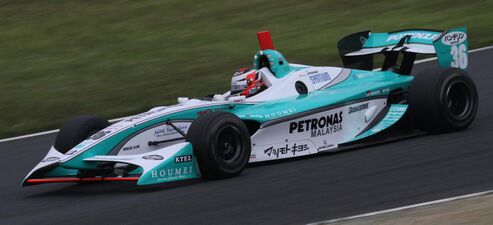Swift Engineering
Topic: Company
 From HandWiki - Reading time: 9 min
From HandWiki - Reading time: 9 min
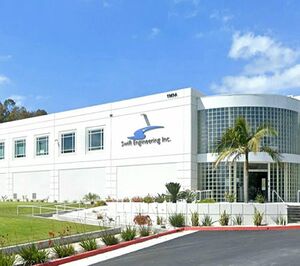 Swift Engineering headquarters in San Clemente | |
| Formerly | Swift Racing Cars |
|---|---|
| Type | Private, Aerospace manufacturer |
| Industry | Aerospace engineering, Aerospace manufacturer, UAS |
| Genre | Aerospace engineering |
| Founded | 1983 California , USA |
| Headquarters | San Clemente, California , |
Area served | Worldwide |
Key people | |
| Products | UAS UAV Advance electronic sensors & systems |
| Brands | Swift Crane, Swift SULE |
| Owner | Matsushita International Corp (100%) |
Number of employees | <500 |
| Parent | Matsushita International Corp |
| Divisions | Aeronautics Systems Defense Systems Mission Systems Space Systems |
| Subsidiaries | |
| Website | swiftengineering |
Swift Engineering is an American spacecraft engineering firm that builds autonomous systems, helicopters, submarines, spacecraft, ground vehicles, robotics, and composite parts. The Chairman and CEO is Hiro Matsushita the former racecar driver and grandson of the founder of Panasonic, Konosuke Matsushita. Swift used to produce racing cars for open-wheel racing series, including Formula Ford, Formula Atlantic, the Champ Car World Series and Formula Nippon, having designed and fabricated over 500 race cars. Swift is AS9100, ISO 14001, and ISO 27000 certified.
History
Swift Engineering was founded in 1983 by David Bruns, Alex Cross, R. K. Smith, and Paul White under the name Swift Racing Cars.[4] Their first car, the DB-1, was a Formula Ford which won the SCCA National Championship in its debut race.[5] The company later built cars for Sports 2000, Formula Ford 2000, Formula Atlantic, and CART. Swift chassis won the Atlantic Championship from 1989 to 1992 and British Formula Renault in 1990.
In 1991, Swift was purchased by Panasonic executive and former Indycar racing driver Hiro Matsushita,[6] grandson of Panasonic founder Konosuke Matsushita,[7] who renamed the firm Swift Engineering. Under his direction, Swift moved up to the CART World Series for 1997, with two cars entered by Newman/Haas Racing and driven by Michael Andretti and Christian Fittipaldi. In CART, Swifts got four wins and 24 podiums from 182 race entries. Tarso Marques was the last driver to race a Swift chassis in CART in the 2000 season.
In 2000, Swift Engineering started to provide vertically integrated, multi-disciplined product development services including design, development, engineering, testing, and rapid manufacturing of prototypes, demonstrators, and pre-production articles.
Swift Engineering established its initial overseas office in 2018 by forming a joint venture with the Kobe Institute of Computing. The joint venture is called Swift Xi (ja) and is located in Kobe. Dr. Nick Barua, a physicist and executive hailing from Yale University, has been thoroughly in charge of management since 2018.[8]
Racing cars
The first Swift racecar was the DB-1 Formula Ford. The car won its debut race, the 1983 SCCA Runoffs at Road Atlanta. The DB-1 was the third car designed by Bruns and was considered to be a design simplification of Burns's previous design, the Automotive Development ADF. The car was considered a landmark design that rendered prior Formula Ford models obsolete. The DB-1 had the lowest aerodynamic drag of any Formula Ford at its release. Over 100 DB-1s were sold in the 18 months following the car's release. The car won 10 Formula Ford championships over the next 13 years. The closely related DB6 won an additional six championships with the last one in 2008. The success of the car was considered one of the factors that resulted in the slow decline of Formula Ford in the US after 1984.[9][10][11]
In 1998, Swift became the sole supplier for the new spec regulation Toyota Atlantic Championship. In 2006, the Atlantic race series became a part of the Champ Car (formerly CART) organization and was renamed the Champ Car Atlantic Championship Powered by Mazda. Swift built a new car for the series, using 016.a as a chassis code. Swift became the sole supplier of chassis for the Japanese Formula Nippon championship in 2009 with the 017.n chassis (also known as the FN09).[12] An updated model called SF13 was used in 2013. The company proposed a derivative of the 017.n, the 020.I, in response to Indy Lights' requirement for a new chassis for the 2014 season.[13]
| Year | Car | Racing Series | Image | Title |
|---|---|---|---|---|
| 1983 | Swift DB1 | Formula Ford 1600[14] | ||
| 1984 | Swift DB2 | Sports 2000[15] | 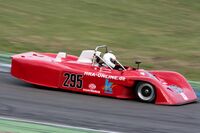 |
Michael Ringström driving a Swift DB2 at the qualification of Suttgarter Rössle's AvD 100 Meilen race |
| 1988 | Swift DB3 | Formula Ford 2000[16] | ||
| 1989 | Swift DB4 | Formula Atlantic[17] | ||
| 1990 | Swift DB5 | Sports 2000"1990 Swift". http://www.race-cars.com/carsold/swift/1202950175/1202950175ss.htm.[18] | ||
| 1991 | Swift DB6 | Formula Ford 2000 1600/2000 | ||
| 1997 | Swift 007.i | CART[19] |  |
Mario Andretti at 1998 Goodwood Festival of Speed with Swift 007.I |
| 1998 | Swift 008.a | Formula Atlantic[20] | ||
| 1998 | Swift 009.c | CART | ||
| 1999 | Swift 010.c | CART[21] | ||
| 2000 | Swift 011.c | CART | ||
| 2002 | Swift 014.a | Formula Atlantic[22] | 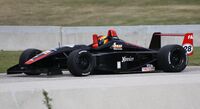 |
Jason Byers holds his arm up to the crowd after winning the Formula Atlantic class at the 2012 SCCA National Championship Runoffs |
| 2006 | Swift 016.a | Formula Atlantic[23] | 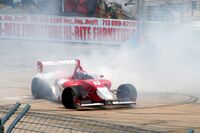 |
Raphael Matos celebrating a victory in his Swift 016.a Atlantic Championship car in 2007 |
| 2009 | Swift 017.n | Formula Nippon[24] |  |
Heamin Choi celebrating in his Swift 017.n |
Aviation
Beginning in 1997, Swift diversified into aerospace/aviation markets, working with major companies including Northrop Grumman, Boeing, Lockheed Martin, SpaceX, Sikorsky, and others. Swift has also worked for governmental agencies such as NASA.
Killer Bee
Swift Engineering designed, built, and delivered the runway-independent Killer Bee blended wing UAV and its mobile launch/retrieval system in 2002. Northrop Grumman bought the Killer Bee UAV product line from Swift Engineering, and renamed it as the Northrop Grumman Bat in April 2009.[25] It has been used primarily as an ISR gathering tool, and features a 10-ft wingspan with 30-lb payload capacity.
Eclipse 400
In 2007 Swift Engineering produced the prototype Eclipse 400 single-engine jet aircraft under contract to Eclipse Aviation. The aircraft was built in secrecy at NASA's Wallops Flight Facility in Virginia and first flown on 2 July 2007.[26] Swift supplies high-strength, low-weight composite parts and assemblies to several aerospace industry customers. Engineering consultancy and designing and producing tooling for composite parts are further aspects of the business.[27]
Sikorsky–Boeing SB-1 Defiant
Swift Engineering Inc. joined the Sikorsky-Boeing team in 2015 to support the development of the Sikorsky–Boeing SB-1 Defiant Multi-Role Technology Demonstrator (JMR TD), with the design and manufacturing of a significant portion of the airframe structure.[28]
Swift020/021
In 2014, Swift started developing the Swift020 fully electric, fully autonomous VTOL UAS. This aircraft is runway-independent and transitions to horizontal flight through its autopilot software.[29] the first UAS featuring X-blade technology, made its first fully autonomous flight demonstration in the city of Kobe, Japan on July 21, 2018.[30] It takes off and lands like a quadrotor but transitions to efficient fixed-wing forward flight without additional launch and recovery equipment, vastly reducing operational time and cost.[31][32] It has a 4-meter wingspan, 2–3 hours of endurance, and a 1.5-kg payload.
Swift Crane
The Swift Crane (ja) is a VTOL unmanned aerial vehicle designed and developed by Swift Engineering. It boasts a fixed-wing design and can take off and land vertically, making it an ideal choice for a vast range of applications. This drone features a large wing and four propellers, which allow it to achieve excellent speed and manoeuvrability in the air. Swift Engineering initially released the Swift020 model, which was primarily used for research and development purposes, and later upgraded it to the Swift021. The latest version of the drone, the Swift Crane, is a commercialized variant that offers exceptional performance and reliability.[33]
Swift Ultra Long Endurance (SULE)
In 2018 Swift proposed to design, fabricate, and fly a Swift Ultra Long Endurance (SULE) 30-day mission high-altitude long endurance (HALE) UAS with flight tests including 24-hrs, 48-hrs, and 7-days during the Phase 2 timeline for NASA.[34] All operations, ground control, safety, reviews, and payload will be included in these test flights and within the proposed 2-year timeframe.[35] Swift HALE completed its first test flight from Spaceport America in New Mexico in 2020.[36]
XLUUV submarine
In 2017, Swift Engineering designed, fabricated, and delivered QTY 10, 10-ft Iridium NEXT payload adapter cylinders, and structures for a 50 ft. XLUUV unmanned submarine.
Structure
Swift Engineering is the parent of a diverse set of subsidiaries.
| Subsidiary | Business | Executive Leader |
|---|---|---|
| Swift Xi Inc. | Engineering Company | Nick Barua - COO[37] |
| Swift Autonomy | A complete UAS suite service company | Hamilton Rencurrel, Caleb Joiner |
| Hyperkelp | Ocean data as a service company [38] | Graeme Rae - CEO |
Recognitions
Swift Engineering has been nominated and recognized multiple times in the past few years for its program management techniques and its quality management techniques due to the extensive programs Swift has been involved with.
- 2012: Swift Engineering received the JEC Americas Innovation Award for its out-of-autoclave process[39]
- 2012: Northrop Grumman Small Business Supplier of the Year, awarded from 1500 suppliers
- 2013: Swift Engineering has been chosen as a "Best in Class" A&D Company to Watch by Aviation Week[40]
- 2015: Boeing Supplier of the Year nomination in 2015
- 2017: Swift Engineering was awarded "Best Intrapreneurship" by OCTANe, Orange County's technology, and life sciences accelerator organization, during the annual High Tech Innovations event held Oct. 13, 2017, in Newport Beach, CA.
- 2018: Swift proposed to design, fabricate, and fly a Swift Ultra Long Endurance (SULE) 30-day mission HALE UAS with flight tests including 24-hrs, 48-hrs, and 7-days during the Phase 2 timeline for NASA. All operations, ground control, safety, reviews, and payload will be included in these test flights and within the proposed 2-year timeframe.[41]
- 2019: Swift Engineering has been selected out of 25 companies around the world to install a UAS academy for the Ministry of National Security (Bahamas), to deploy a suite of drones to support the country's command, control, communication, and ISR efforts.[42]
- 2019: Swift is delivering a pair of low-cost (90% reduction), low-weight (50% reduction) telepresence robotic arm replacements to NASA for their Valkyrie humanoid robotic assembly.
- 2019: Swift Engineering has been selected for the design and construction of Future Attack Reconnaissance Aircraft (FARA) Airframe for Sikorsky.[43]
References
- ↑ "US developer and manufacturer of drones. SWIFT Engineering establishes company in Kobe". https://www.jetro.go.jp/en/invest/newsroom/2018/e77c744e435877be.html.
- ↑ "Nick Barua COO". December 22, 2020. https://workinkobe.lg.jp/interview/576/?lang=en.
- ↑ "Revolutionizing Drone Technology to Empower the Bahamas". 23 August 2021. https://www.swiftautonomy.com/press/revolutionizing-drone-technology-to-empower-the-bahamas/.
- ↑ "Rekindling The Flame". http://www.champcaratlantic.com/News/Article.asp?ID=2108.
- ↑ "First Win PR". http://www.apexspeed.com/swift/documents/FirstWinNewsRelease.pdf.
- ↑ Henderson, Martin (1997-09-24). "HIRO AT LARGE" (in en-US). https://www.latimes.com/archives/la-xpm-1997-sep-24-sp-35775-story.html.
- ↑ https://www.panasonic.com/global/corporate/history/konosuke-matsushita.html/ The Founder, Konosuke Matsushita
- ↑ "Dr. Nick Barua: Multi-Faceted Career of Yale Physicist to Japan's Business Icon". May 11, 2023. https://timeiconic.com/dr-nick-barua-multi-faceted-career-of-yale-physicist-to-japans-business-icon/.
- ↑ Egan, Peter (March 1984). "Swift DB-1, Testing the new Formula Ford national champion". Road and Track. pp. 61–63.
- ↑ Nickless, Steve (1993). Anatomy & Development of the Formula Ford Race Car. Osceola, WI: Motorbooks International. pp. 59–63, 116. ISBN 087938-807-2.
- ↑ Zurschmeide, Jeff (July 2017). "They Can't Do That... Can They?". Sports Car Magazine (SCCA): pp. 32–37. https://www.scca.com/articles/2010089-sportscar-feature-impossible.
- ↑ "2009 Formula Nippon cars to be made in USA". http://www.autoblog.com/2007/08/30/2009-formula-nippon-cars-to-be-made-in-usa/.
- ↑ Pruett, Marshall (August 28, 2012). "INDYCAR: Swift Files 2014 Indy Lights Proposal". SPEED Channel. Fox Sports. http://auto-racing.speedtv.com/article/indycar-swift-files-2014-indy-lights-proposal/.
- ↑ "1989 Swift DB-1 Formula Ford". 2018-05-18. https://bringatrailer.com/listing/1989-swift-db-1-formula-ford-race-car/.
- ↑ "Swift DB2 Sports 2000". 2021-03-01. https://motorsportsmarket.com/racecars/swift-db2-sports-2000/.
- ↑ "Breaking Swift DB3". https://racecarsdirect.com/Advert/Details/88980/breaking-swift-db3.
- ↑ "Swift DB4 Formula Atlantic". https://racecarsdirect.com/Advert/Details/120637/swift-db4-formula-atlantic.
- ↑ "1990 Swift DB5-L Spec Sheet". 2010-01-07. http://www.race-cars.com/carsold/swift/1202950175/1202950175ss.htm.
- ↑ "Swift 007.i chassis, which was driven by Micheal Andretti.". September 28, 2018. https://beyondtheflag.com/2018/09/28/cart-season-review-1997-ppg-world-series/.
- ↑ "1998 Swift 008/014 Formula Atlantic". https://bringatrailer.com/listing/1998-swift-008014-formula-atlantic/.
- ↑ "1999 Swift 010.c Indycar". https://www.conceptcarz.com/z29728/swift-010c-indycar.aspx.
- ↑ Huschilt, Tom; Norris, Chris; Roberts, Neil; Page, Mark (2002-12-02). "Development of the Swift 014.a Racecar for the CART Toyota Atlantic Championship Series 2002-01-3301". doi:10.4271/2002-01-3301. https://www.sae.org/publications/technical-papers/content/2002-01-3301/.
- ↑ "Swift 016 Formula Atlantic". 2002-12-02. https://showroom.windingroad.com/listings/product/2163/.
- ↑ "Racecar-Engineering". December 11, 2007. https://www.racecar-engineering.com/articles/swift-017-n/.
- ↑ "Bat Unmanned Aerial Vehicle (UAV)". https://www.airforce-technology.com/projects/northropgrummanbat/.
- ↑ Trautvetter, Chad (July 2007). "Eclipse Goes Solo with Concept Jet". http://www.avweb.com/news/airventure/EAAAirVenture2007_EclipseConceptJet_195692-1.html.
- ↑ https://minijets.org/en/300-500/pwc-610f/eclipse-concept-jet/ Eclipse Concept Jet (ECJ)
- ↑ "Swift Joins Sikorsky-Boeing Defiant Team to deliver Next Generation Vertical Lift" (Press release).
- ↑ Press (2020-05-01). "Swift UAS Teams Break New Ground in Japan" (in en-gb). https://www.suasnews.com/2020/05/swift-uas-teams-break-new-ground-in-japan/.
- ↑ "Swift Engineering Inc. successfully flies VTOL drone Swift020 in Kobe, Japan.". November 5, 2018. https://www.suasnews.com/2018/11/swift-engineering-inc-successfully-flies-vtol-drone-swift020-in-kobe-japan/.
- ↑ "Swift021 – A Fully Autonomous VTOL UAS". https://swiftengineering.com/swift020/.
- ↑ Schroth, Frank (April 29, 2017). "Swift Engineering's VTOL Solutions for the UAS Industry – the Swift 020". https://dronelife.com/2017/04/29/49104/.
- ↑ "Long-Range Drone Takes Off, Lands like a Bird". https://www.asme.org/topics-resources/content/long-range-drone-takes-off,-lands-like-a-bird.
- ↑ "NASA Small Business Partnership Prepares Drone for 30-Day Science Flights". August 4, 2020. https://www.nasa.gov/feature/ames/nasa-small-business-partnership-prepares-drone-for-30-day-science-flights/.
- ↑ "Swift Ultra Long Endurance (SULE) Unmanned Air Vehicle (UAV), Phase II". https://data.nasa.gov/dataset/Swift-Ultra-Long-Endurance-SULE-Unmanned-Air-Vehic/i9cw-bz9c/data/.
- ↑ Swift Engineering (July 20, 2020). "American made Swift High Altitude Long Endurance UAS Completes Landmark Flight" (Press release).
- ↑ "Nick Barua: Creating Opportunities through Innovation". https://theincmagazine.com/nick-barua-creating-opportunities-through-innovation/.
- ↑ "HyperKelp Collaborates with Northrop Grumman to Monitor Glacier Melt". https://www.prweb.com/releases/2022/01/prweb18416400.htm.
- ↑ "JEC Innovation Awards Program 2012 - 13 companies rewarded for their composite innovations". February 16, 2012. http://www.jeccomposites.com/about-jec/press-releases/jec-innovation-awards-program-2012-13-companies-rewarded-their-composite.
- ↑ "Aviation Week — November 11/18 2013". https://archive.aviationweek.com/issue/20131111.
- ↑ "Swift Ultra Long Endurance (SULE) Unmanned Air Vehicle (UAV), Phase II". https://data.nasa.gov/dataset/Swift-Ultra-Long-Endurance-SULE-Unmanned-Air-Vehic/i9cw-bz9c/data/.
- ↑ "Govt signs $17 mil. contract for drones". 17 December 2019. https://thenassauguardian.com/govt-signs-17-mil-contract-for-drones/.
- ↑ "Swift Engineering Selected for the Design and Construction of FARA Airframe for Sikorsky, a Lockheed Martin Company". Bloomberg.com. 23 December 2019. https://www.bloomberg.com/press-releases/2019-12-23/swift-engineering-selected-for-the-design-and-construction-of-fara-airframe-for-sikorsky-a-lockheed-martin-company.
External links
- Swift Engineering web site
- JUSTIA
- Road and Track road test of the Swift DB-1 Formula Ford
- NASA
- The Bridge
- Forbes Japan
 |
 KSF
KSF